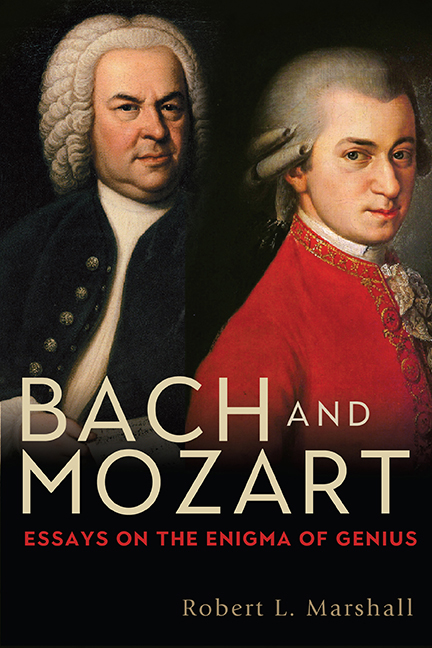Book contents
- Frontmatter
- Dedication
- Epigraph
- Contents
- List of Figures
- Preface
- List of Abbreviations
- Prologue. The Century of Bach and Mozart as a Music-Historical Epoch: A Different Argument for the Proposition
- 1 Young Man Bach: Toward a Twenty-First-Century Bach Biography
- 2 The Notebooks for Wilhelm Friedemann and Anna Magdalena Bach: Some Biographical Lessons
- 3 Bach and Luther
- 4 Redeeming the St. John Passion–and J. S. Bach
- 5 Bach's Keyboard Music
- 6 The Minimalist and Traditionalist Approaches to Performing Bach's Choral Music: Some Further Thoughts
- 7 Truth and Beauty: J. S. Bach at the Crossroads of Cultural History
- 8 Bach at Mid-Life: The Christmas Oratorio and the Search for New Paths
- 9 Bach at the Boundaries of Music History: Preliminary Reflections on the B-Minor Mass and the Late-Style Paradigm
- 10 Father and Sons: Confronting a Uniquely Daunting Paternal Legacy
- 11 Johann Christian Bach and Eros
- 12 Bach and Mozart: Styles of Musical Genius
- 13 Mozart and Amadeus
- 14 Bach and Mozart's Artistic Maturity
- 15 Mozart's Unfinished: Some Lessons of the Fragments
- Epilogue (ossia Postmortem). Had Mozart Lived Longer: Some Cautious (and Incautious) Speculations
- Notes
- Works Cited
- Index
- Miscellaneous Endmatter
- Eastman Studies in Music
6 - The Minimalist and Traditionalist Approaches to Performing Bach's Choral Music: Some Further Thoughts
Published online by Cambridge University Press: 29 March 2020
- Frontmatter
- Dedication
- Epigraph
- Contents
- List of Figures
- Preface
- List of Abbreviations
- Prologue. The Century of Bach and Mozart as a Music-Historical Epoch: A Different Argument for the Proposition
- 1 Young Man Bach: Toward a Twenty-First-Century Bach Biography
- 2 The Notebooks for Wilhelm Friedemann and Anna Magdalena Bach: Some Biographical Lessons
- 3 Bach and Luther
- 4 Redeeming the St. John Passion–and J. S. Bach
- 5 Bach's Keyboard Music
- 6 The Minimalist and Traditionalist Approaches to Performing Bach's Choral Music: Some Further Thoughts
- 7 Truth and Beauty: J. S. Bach at the Crossroads of Cultural History
- 8 Bach at Mid-Life: The Christmas Oratorio and the Search for New Paths
- 9 Bach at the Boundaries of Music History: Preliminary Reflections on the B-Minor Mass and the Late-Style Paradigm
- 10 Father and Sons: Confronting a Uniquely Daunting Paternal Legacy
- 11 Johann Christian Bach and Eros
- 12 Bach and Mozart: Styles of Musical Genius
- 13 Mozart and Amadeus
- 14 Bach and Mozart's Artistic Maturity
- 15 Mozart's Unfinished: Some Lessons of the Fragments
- Epilogue (ossia Postmortem). Had Mozart Lived Longer: Some Cautious (and Incautious) Speculations
- Notes
- Works Cited
- Index
- Miscellaneous Endmatter
- Eastman Studies in Music
Summary
[If] returning from the underworld, you could see Bach (to mention him particularly, since he was not long ago my colleague at the Leipzig St. Thomas School) … watching over everything and bringing back to the rhythm and the beat, out of thirty or even forty musicians [symphoniaci], the one with a nod, another by tapping with his foot, the third with a warning finger …
—Matthias Gesner, 1738
Thus wrote Matthias Gesner (1691–1761) in a footnote to his 1738 edition of the Roman orator Quintilian's famous treatise on rhetoric, the Institutio Oratoria. Gesner was the first professor of classical philology at the University of Göttingen. Previously—specifically, for the four years from 1730 to 1734—he was the rector of the Thomasschule in Leipzig; that is, he was Johann Sebastian Bach's boss, and, as this passage makes clear, he was an enthusiastic eyewitness to Bach's performances as a conductor.
If Gesner can be believed, Bach directed an ensemble of “thirty or even forty musicians.” Can we believe him? Does it matter?
The question of the original size of Bach's orchestra and chorus has been a mat-ter of heated debate for close to forty years now, ever since Joshua Rifkin presented a revolutionary paper entitled “Bach's Chorus” at the 1981 annual meeting of the American Musicological Society (AMS). Rifkin argued that Bach's chorus normally consisted of a single singer on each part, literally a solo quartet: one soprano, one alto, one tenor, and one bass. It fell to me on that occasion to serve as a respondent to the bold thesis. I disagreed with my good friend Rifkin, but the discussion by no means ended on that November day in Boston. According to a bibliographical checklist devoted to the controversy compiled by Matthew Cron and published in Bach: Journal of the Riemenschneider Bach Institute, no fewer than fifty-four articles had appeared by the end of 1997.
The AMS session was reviewed soon after the event in the New Yorker; Rifkin and I published an exchange of views in High Fidelity magazine and another in the Musical Times a year or so later.
- Type
- Chapter
- Information
- Bach and MozartEssays on the Engima of Genius, pp. 114 - 120Publisher: Boydell & BrewerPrint publication year: 2019



